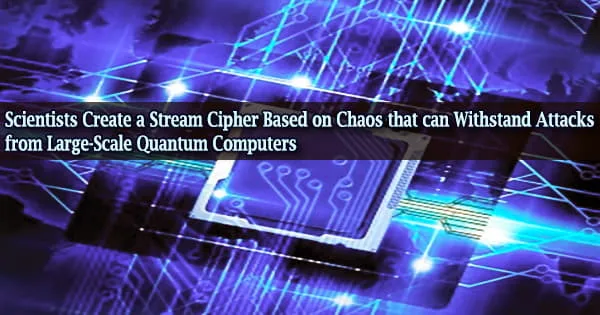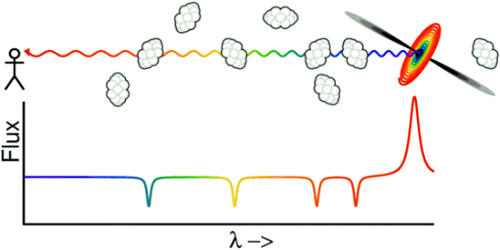Fast algorithms could quickly break many widely used cryptosystems on quantum computers, forcing more novel digital security solutions. There has been a lot of study in recent years on quantum computers, which use quantum mechanical processes to solve mathematical problems that are difficult or impossible for traditional computers to answer.
A group of experts have developed a stream cipher that consists of three cryptographic primitives based on distinct mathematical models of chaos. The resulting cryptographic technique is resistant to attacks from large-scale quantum computers and can be implemented on low-cost processors, paving the door for secure post-quantum digital communications.
A cryptosystem is a set of cryptographic algorithms and infrastructure that work together to offer information security. A cipher system is another name for a cryptosystem. It is a full system that includes key generation algorithms, encryption, and decryption techniques to ensure data confidentiality.
The goal of post-quantum cryptography (also known as quantum-resistant cryptography) is to create cryptographic systems that are secure against both quantum and classical computers while still being able to communicate with existing protocols and networks.
Cryptographic systems are a vital aspect in the realm of digital communications, even if they are “under the hood” for most of us. Quantum computers are set to revolutionize the world of cryptography.
Fast algorithms on these machines have the potential to break some of the most extensively used cryptosystems, making them vulnerable. Cryptography researchers all across the world are working on new encryption methods that can withstand attacks from quantum computers, well aware of the approaching threat.
Chaos theory is being investigated as a foundation for post-quantum cryptosystems. Chaos is a feature of certain dynamic systems that renders them particularly sensitive to initial conditions, according to mathematics.
The implementation and running costs of our cryptosystem are remarkably low compared with those of quantum cryptography. Our work thus provides a cryptographic approach that guarantees the privacy of daily communications between people all over the world in the post-quantum era.
Professor Takaya Miyano
While technically deterministic (non-random), these systems evolve in such complicated ways that forecasting their long-term state with inadequate information is nearly impossible, as even little rounding mistakes in the beginning conditions produce divergent conclusions.
As a team of researchers from Ritsumeikan University in Japan demonstrated in a recent paper published in IEEE Transactions on Circuits and Systems I, chaotic systems’ unique property can be used to create highly secure cryptographic systems.
Professor Takaya Miyano led a team that created an unheard-of stream cipher made up of three cryptographic primitives based on separate mathematical models of chaos. The first primitive is an enhanced Lorenz (AL) map-based pseudorandom number generator.
The pseudorandom numbers generated in this way are used to generate key streams for encrypting/decrypting communications, which are employed in the second and possibly most notable primitive, a new mechanism for secret-key exchange.
The synchronization of two chaotic Lorenz oscillations, which can be individually and arbitrarily initialized by the two communicating users, without either knowing the state of the other’s oscillator, is the basis for this unique technique for exchanging secret keys determining the AL map.
The communicating users (the sender and the receiver) mask the value of one of their oscillator’s variables by multiplying it with a locally produced random number to hide the oscillators’ internal states. The sender’s disguised value is subsequently communicated to the receiver and vice versa.
Users can mask and trade secret keys and then locally unmask them with simple computations after a short period when these back-and-forth exchanges lead both oscillators to sync up almost precisely to the same state despite the randomization of the variables.
Finally, the third primitive is a hash function based on the logistic map (a chaotic equation of motion), which allows the transmitter to communicate a hash value and, in turn, the receiver to check that the secret key received is correct, i.e., the chaotic oscillators were properly synchronized.
Because it is theoretically impossible to synchronize their own oscillator to either the sender’s or receiver’s, the researchers demonstrated that a stream cipher built with these three primitives is exceptionally secure and resistant to statistical attacks and eavesdropping.
This is an unprecedented achievement, as Prof. Miyano states: “Most chaos-based cryptosystems can be broken by attacks using classical computers within a practically short time. In contrast, our methods, especially the one for secret-key exchange, appear to be robust against such attacks and, more importantly, even hard to break using quantum computers.”
The suggested key exchange technique is also compatible with existing block ciphers, such as the widely used Advanced Encryption Standard (AES).
Furthermore, the researchers were able to use Python 3.8 to implement their chaos-based stream cipher on the Raspberry Pi 4, a small-scale computer. They even utilized it to send a famous painting by Johannes Vermeer from Kusatsu to Sendai, 600 kilometers distant in Japan.
“The implementation and running costs of our cryptosystem are remarkably low compared with those of quantum cryptography,” highlights Prof. Miyano, “Our work thus provides a cryptographic approach that guarantees the privacy of daily communications between people all over the world in the post-quantum era.”
With the strength of chaos-based cryptography, we may not need to be concerned about the negative aspects of quantum computing.
















